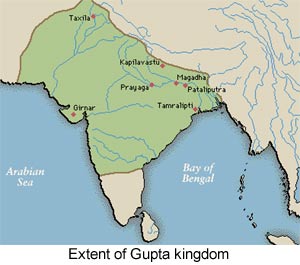

 |  |
 How and from where the Guptas originated is quiet obscure. It is most likely that the family was one of the wealthy landowners of Magadha who gradually gained political control. The dynasty was first recognized with the accession of Chandra Gupta I, who increased the size of his kingdom to give it a definite shape of an empire. Chandra Gupta married a Lichchhavi princess. The Lichchhavis were an old established tribe and marrying into their royal family gave a seal of authority to the Gupta dynasty. Chandra Gupta I ruled over Magadha and parts of eastern Uttar Pradesh (Saketa and Prayaga). He took the title of maharajadhiraja (great king of kings). The Gupta era is taken as dating from his accession in about A.D. 319-20.
How and from where the Guptas originated is quiet obscure. It is most likely that the family was one of the wealthy landowners of Magadha who gradually gained political control. The dynasty was first recognized with the accession of Chandra Gupta I, who increased the size of his kingdom to give it a definite shape of an empire. Chandra Gupta married a Lichchhavi princess. The Lichchhavis were an old established tribe and marrying into their royal family gave a seal of authority to the Gupta dynasty. Chandra Gupta I ruled over Magadha and parts of eastern Uttar Pradesh (Saketa and Prayaga). He took the title of maharajadhiraja (great king of kings). The Gupta era is taken as dating from his accession in about A.D. 319-20.Chandra Gupta I appointed his son Samudra Gupta to succeed him in about A.D. 335. Fortunately, a lengthy eulogy to him was inscribed on an Ashokan pillar at Allahabad which provides the basic information on his reign. There was trouble over the successor to Chandra Gupta I, and the coins of an obscure prince Kacha suggest that Samudra Gupta had a rival in him and that he finally overcame it. Samudra Gupta's ambition was to establish an empire controlled from the Gupta capital at Pataliputra and including the entire subcontinent. The shades of the Mauryas were re-emerging on the scene. The eulogy gives an impressive list of kings and regions which succumbed to Samudra Gupta's triumphal march across the country. Four northern kings were conquered mainly in the area around Delhi and western Uttar Pradesh. Kings of the south and the east were forced to pay homage, and from the places mentioned it appears that Samudra Gupta campaigned down the east coast as far as Kanchipuram (near modern Madras). Nine kings of Aryavarta (the western half of the Ganges plain) were 'violently uprooted'. The forest kings (tribal chiefs of central India and the Deccan) were forced to pay tribute, as were the kings in eastern India of Assam and Bengal, and those with small kingdoms in Nepal and the Punjab. Nine republics in Rajasthan, including the age-old Malavas and Yaudheyas, were forced to accept Gupta suzerainty. In addition, foreign kings, such as the Daivaputra Shahanushahi ('Descendant of the Son of Heaven, King of Kings', a Kushana title), the Shakas, and the king of Ceylon also paid tribute, as did the inhabitants of all the islands. The list of conquests is impressive. The kings of the south and of the Deccan were not under the suzerainty of Samudra Gupta but paid him tribute, as did a number of the northern rulers. In the end his conquests resulted in the annexation of territory in northern India as he originally intended, and also the exaction of tribute from defeated rulers whose territory he could not annex. His direct political control extended from Punjab up till Narmada, and including Rajasthan and Bengal in the west and east respectively. continued.... next page >> |
Copyright ©2000 indiansaga.info. All rights reserved.
By using this service, you accept that you won't copy or use the data given in this website for any commercial purpose.
The material on indiansaga.info is for informational & educational purpose only.
This site is best viewed at 800 X 600 picture resolution.